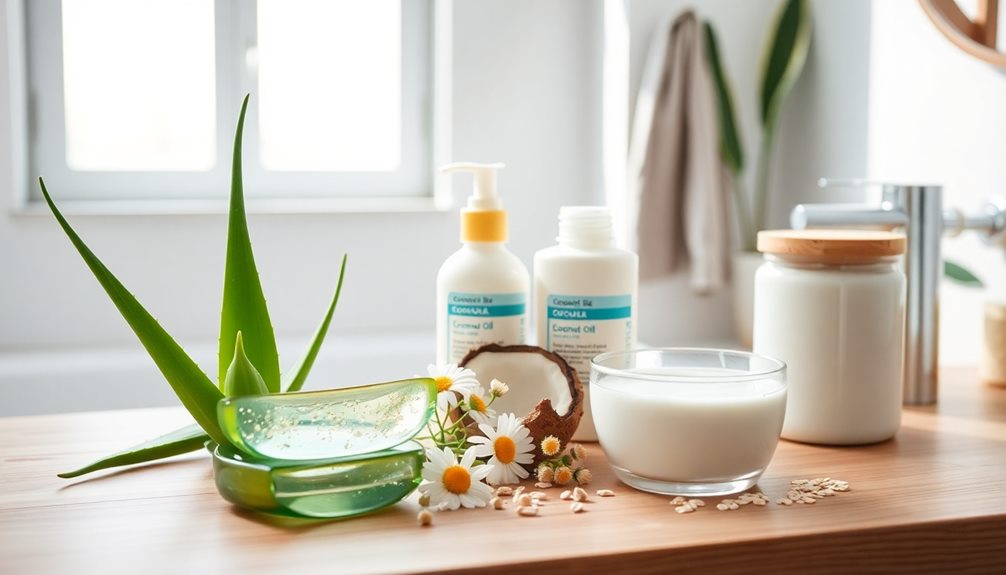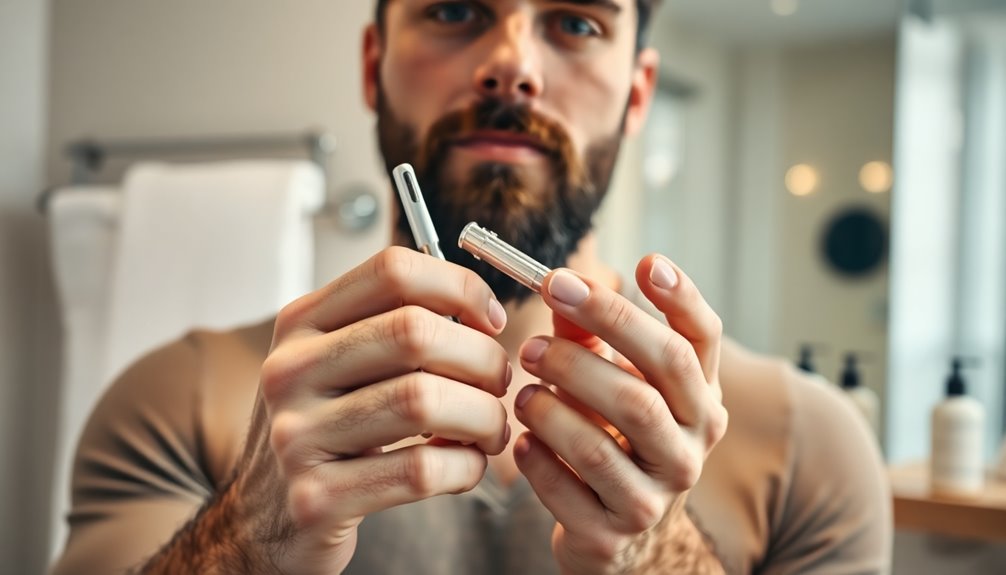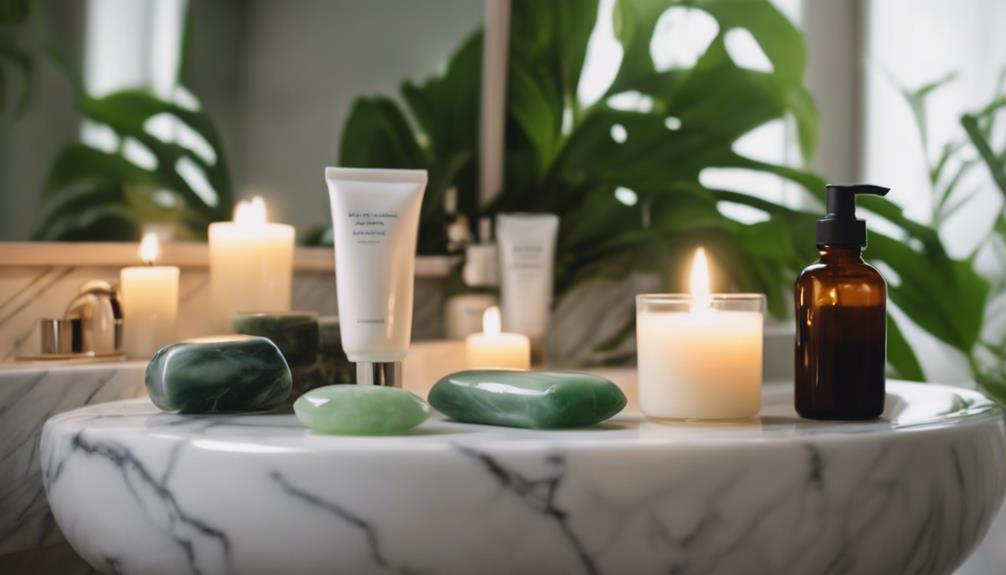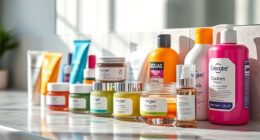If you want the best natural skincare for sensitive skin, consider these top ten science-backed ingredients. First up is hyaluronic acid, which hydrates and boosts your skin barrier. Jojoba oil mimics natural oils and keeps your skin moisturized. Ceramides lock in moisture, while squalane provides deep hydration without clogging pores. Green tea soothes inflammation and protects against UV damage. Oatmeal calms irritations and strengthens your skin barrier. Niacinamide improves texture and increases hydration. Bakuchiol offers anti-aging benefits without irritation, and shea butter nourishes deeply. There's plenty more to discover about these ingredients and their benefits!
Key Takeaways
- Hyaluronic Acid is a powerful humectant that hydrates and strengthens the skin barrier, making it ideal for sensitive skin.
- Jojoba Oil mimics natural skin oils, retaining moisture without clogging pores, and is suitable for all skin types, including sensitive and acne-prone.
- Ceramides are essential for maintaining the skin barrier and improving hydration, reducing irritation risk in sensitive skin.
- Green Tea provides anti-inflammatory and antioxidant benefits, protecting skin from irritation and environmental stressors.
- Bakuchiol is a gentle alternative to retinol, offering anti-aging benefits without the harsh side effects, perfect for sensitive skin.
Hyaluronic Acid
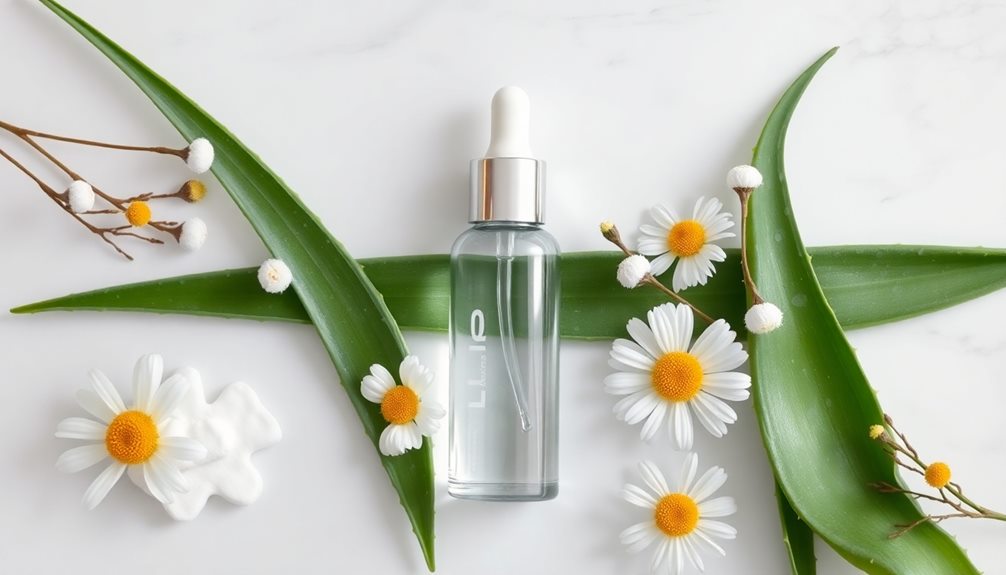
Hyaluronic acid is a powerhouse for anyone dealing with sensitive skin. This naturally occurring substance can hold up to 1,000 times its weight in water, making it an incredible humectant that enhances hydration levels.
If you're struggling with dryness or sensitivity, incorporating hyaluronic acid into your routine can be a game changer. It effectively draws moisture from the environment, instantly plumping your skin and providing the hydration it craves.
One of the standout benefits of hyaluronic acid is its ability to strengthen the skin barrier. By doing so, it reduces water loss, which is essential for maintaining ideal hydration levels. This improvement in skin texture and elasticity can lead to a more radiant, healthier appearance.
You'll appreciate that hyaluronic acid is non-irritating and suitable for all skin types, including yours.
Look for moisturizers and serums that feature hyaluronic acid, as they often provide both immediate and long-lasting hydration benefits.
When you choose products with this superstar ingredient, you're taking a significant step toward soothing your sensitive skin, ensuring it stays well-hydrated and comfortable.
Jojoba Oil
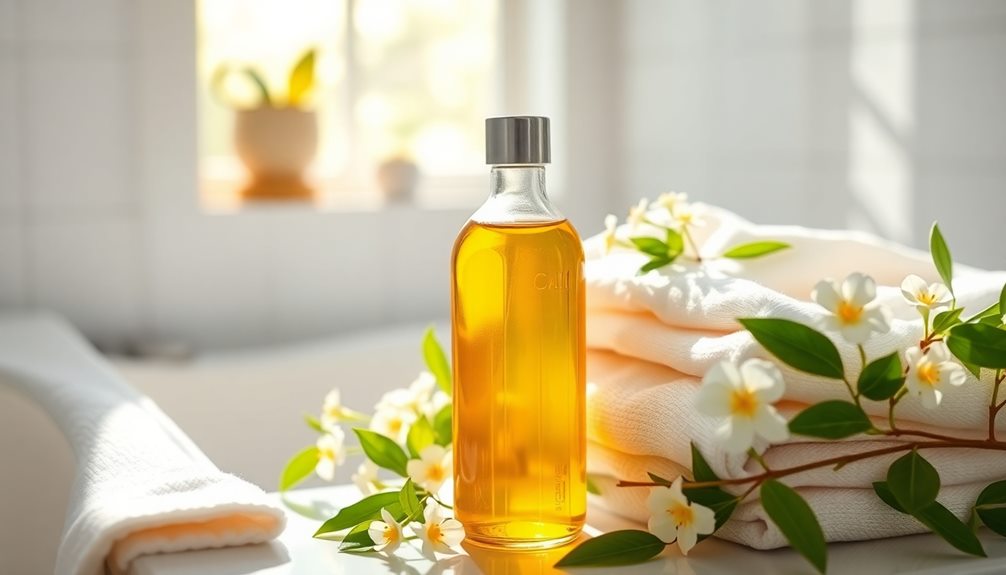
Jojoba oil is a fantastic option for keeping your skin hydrated without clogging your pores.
Its anti-inflammatory properties can soothe irritation, making it a great choice if you have sensitive skin.
Plus, since it's non-comedogenic, you won't have to worry about breakouts while enjoying its moisturizing benefits.
Moisture Retention Benefits
When it comes to moisture retention for sensitive skin, few ingredients rival jojoba oil in effectiveness. This natural moisturizer closely mimics your skin's natural sebum, helping to regulate oil production and retain moisture without clogging pores.
By incorporating jojoba oil into your routine, you can enjoy several remarkable benefits:
- Enhanced Hydration: Jojoba oil is rich in vitamins E and B, which boost skin hydration and nourish your complexion.
- Improved Skin Barrier: Its unique structure allows jojoba oil to penetrate deeply, forming a protective layer on the surface that prevents moisture loss.
- Non-Comedogenic Properties: Unlike some moisturizers, jojoba oil won't cause breakouts, making it suitable for sensitive and acne-prone skin.
Studies show that jojoba oil can greatly improve skin elasticity and hydration levels, making it a powerful ally for anyone dealing with dry or sensitive skin conditions.
By maintaining your skin barrier and delivering essential nutrients, jojoba oil offers an effective solution for achieving lasting moisture retention, ensuring your skin remains healthy and hydrated.
Embrace this versatile ingredient, and watch your skin thrive!
Anti-Inflammatory Properties
For those struggling with sensitive skin, incorporating jojoba oil into your skincare routine can make a significant difference thanks to its remarkable anti-inflammatory properties. This oil mimics your skin's natural sebum, effectively helping to soothe irritated skin and reduce redness associated with various sensitivities.
Its rich composition of vitamins E and B, along with powerful antioxidants, forms a protective barrier that calms inflammation and prevents moisture loss. Additionally, the emotional aspects of caring for your skin can be linked to navigating difficult conversations with oneself and fostering a positive relationship with your body.
Research has shown that jojoba oil is particularly beneficial for skin conditions like eczema and psoriasis. Its anti-inflammatory compounds work to alleviate symptoms, promoting overall skin health and comfort.
Additionally, jojoba oil enhances your skin barrier function, which is essential for reducing sensitivity and preventing external irritants from triggering inflammation.
Non-Comedogenic Nature
With its unique ability to mimic the skin's natural sebum, jojoba oil stands out as a non-comedogenic ingredient perfect for sensitive skin.
This lightweight oil absorbs easily, ensuring your skin barrier remains intact while providing essential hydration without clogging pores.
Here are three reasons why jojoba oil is a great choice for your skincare routine:
- Non-Comedogenic Properties: Its composition prevents pore blockage, making it suitable for all skin types, including sensitive and acne-prone skin.
- Nourishing Benefits: Packed with vitamins E and B, antioxidants, and essential minerals, jojoba oil nourishes the skin, reducing irritation and the risk of breakouts.
- Oil Regulation: Clinical studies show that jojoba oil can help regulate oil production, striking a balance that keeps your skin hydrated without feeling greasy.
Ceramides
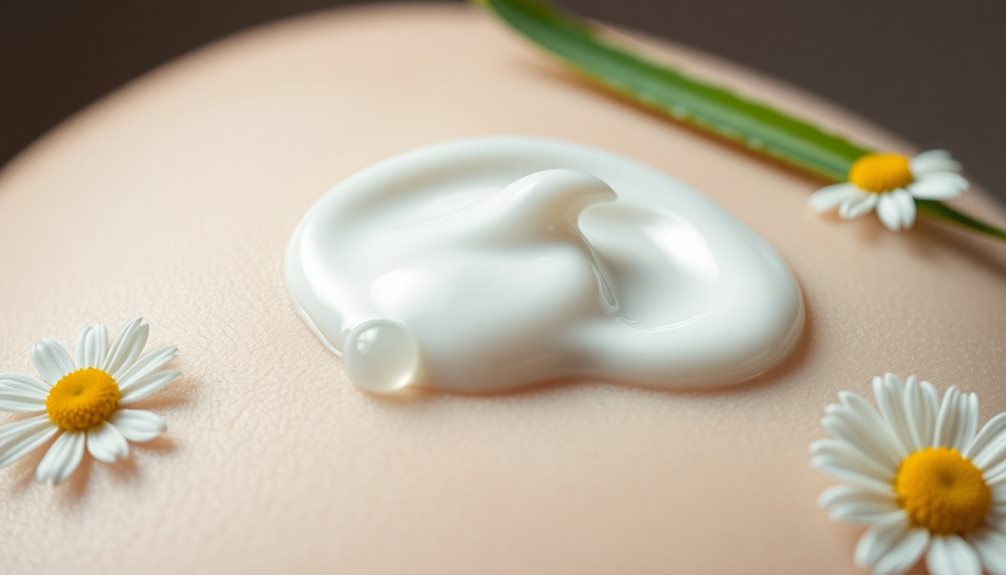
Ceramides play an essential role in maintaining your skin’s barrier, especially if you have sensitive skin. These crucial lipids are found in the outer layer of your skin, helping to lock in moisture and prevent dryness. In addition to retaining moisture, ceramides also aid in protecting your skin barrier function by forming a protective layer that shields against environmental factors and irritants. For people with sensitive skin, maintaining the integrity of the skin barrier function is particularly important, as it can help reduce the risk of irritation and reactions. Ensuring that your skin has an adequate supply of ceramides can contribute to overall skin health and comfort.
As you age, your skin's natural ceramide levels decline, which can lead to increased sensitivity and irritation. Incorporating ceramide-rich moisturizers into your skincare routine can greatly improve hydration and elasticity, making your skin feel more comfortable.
Additionally, herbal alternatives for Botox-like effects can complement the benefits of ceramides, providing a holistic approach to skin health.
Clinical studies have shown that moisturizers containing ceramides enhance overall barrier function, particularly for those with conditions like eczema or psoriasis. Their ability to soothe and reduce inflammation makes them a go-to ingredient for sensitive skin.
Additionally, ceramides boast hypoallergenic properties, minimizing the risk of irritation and making them suitable for a wide range of skin types.
You can find ceramides in various skincare formulations, including cleansers, creams, and, of course, moisturizers.
Squalane
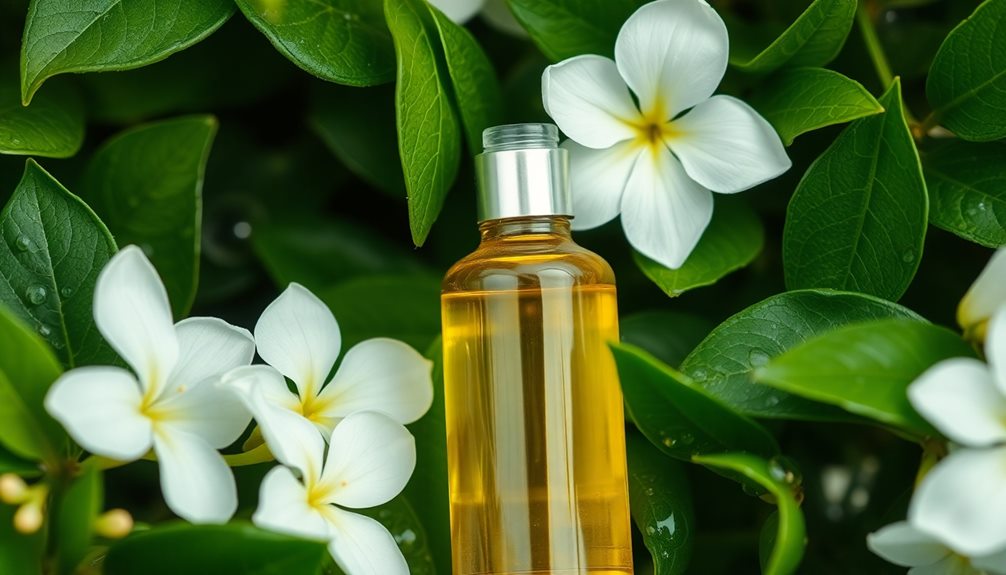
Squalane's unique ability to mimic your skin's natural oils makes it a standout ingredient for sensitive skin. This naturally occurring lipid, derived from olives or sugarcane, delivers deep hydration without clogging your pores.
It's particularly effective for sensitive skin types, thanks to its non-irritating properties that calm inflammation and enhance overall comfort.
Here are three ways squalane can benefit your skincare routine:
- Deep Hydration: Squalane penetrates the skin efficiently, locking in moisture and preventing dryness.
- Improves Skin Texture: Regular use of squalane can greatly improve skin texture, making it feel smoother and more balanced.
- Antioxidant Protection: Its antioxidant properties help protect your skin from environmental damage, promoting a healthier, more radiant complexion.
Incorporating squalane into your skincare regimen not only hydrates but also helps other active ingredients absorb better, maximizing their effectiveness.
If you're looking for a versatile ingredient that can improve skin while keeping sensitivity at bay, squalane is an excellent choice.
Enjoy the benefits of this remarkable ingredient and watch your skin thrive!
Green Tea
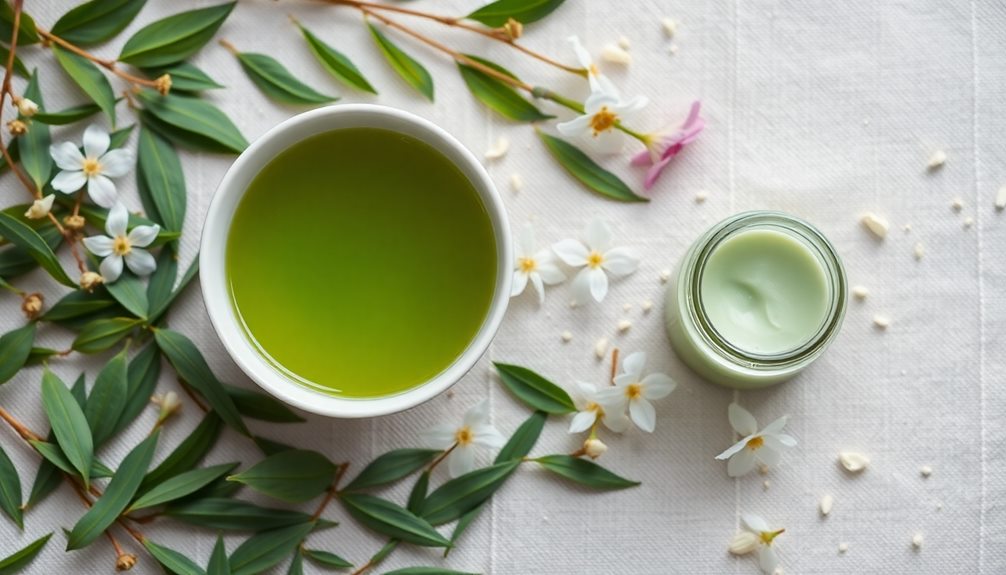
Green tea's antioxidant properties make it a powerhouse for sensitive skin, helping to fight free radicals and reduce inflammation.
You'll appreciate how its anti-inflammatory benefits soothe irritation while protecting your skin from sun damage.
Incorporating green tea into your skincare routine can greatly enhance your skin's overall health and resilience.
Antioxidant Properties Explained
While exploring natural skincare options, you might discover that green tea is a powerhouse ingredient for sensitive skin, thanks to its rich content of polyphenols and catechins.
These compounds are renowned for their potent antioxidant properties, helping to combat oxidative stress and protect the skin from damage caused by free radicals. Additionally, incorporating ingredients like glycolic acid can enhance your skincare routine by promoting cell turnover and improving skin texture, especially for those with sensitive skin.
Incorporating green tea into your skincare routine can lead to remarkable benefits, especially if you have sensitive skin.
Here are three key reasons to embrace green tea:
- Oxidative Protection: Green tea's antioxidants shield your skin from harmful UV radiation and environmental stressors, promoting healthier skin cells.
- Combat Skin Inflammation: The application of green tea extracts can considerably reduce markers of skin inflammation, making it an excellent choice for calming irritated skin.
- Overall Skin Health: Regular use of green tea can improve overall skin health, enhancing texture and reducing signs of aging like fine lines and uneven skin tone.
Anti-Inflammatory Benefits
When it comes to soothing sensitive skin, few ingredients rival green tea for its anti-inflammatory benefits. Rich in polyphenols, particularly epigallocatechin gallate (EGCG), green tea has powerful properties that help reduce inflammation. Studies show that applying green tea extracts topically can considerably decrease redness and irritation linked to conditions like acne and rosacea.
The antioxidant properties of green tea also play an essential role in combating oxidative stress, which can lead to skin inflammation and premature aging. By incorporating green tea into your skincare routine, you enhance your skin barrier function, making your skin more resilient against environmental stressors that trigger inflammation.
Moreover, green tea inhibits the production of pro-inflammatory cytokines, further bolstering its ability to reduce skin inflammation. Regular use of this ingredient not only promotes overall skin health but also provides a calming effect for those with sensitive skin.
Whether you opt for a green tea-infused moisturizer or a soothing serum, you'll be giving your skin the support it needs to thrive while minimizing irritation. Embrace the anti-inflammatory benefits of green tea, and enjoy a calmer, healthier complexion.
Sun Damage Protection
Often overlooked, the protective benefits of green tea against sun damage are impressive. Rich in polyphenols, particularly catechins, green tea offers strong antioxidant properties that shield your skin from harmful UV radiation. By incorporating green tea into your skincare routine, you can greatly enhance your sun damage protection.
Here are three key benefits of using green tea for your skin:
- Reduces Sunburn Severity: Topical application of green tea has been shown to decrease the severity of sunburn and aid skin repair processes after UV exposure.
- Soothes Irritation: Its anti-inflammatory properties provide relief for irritated skin, making it perfect for soothing redness caused by sun exposure.
- Promotes Overall Skin Health: Regularly consuming or applying green tea can improve skin health and reduce signs of aging from sun damage, like fine lines and hyperpigmentation.
With green tea extracts increasingly featured in sunscreens and skincare products, you can easily add this powerhouse ingredient to your regimen. Embrace green tea for its multifaceted benefits and enjoy healthier, more resilient skin.
Rosehip Oil
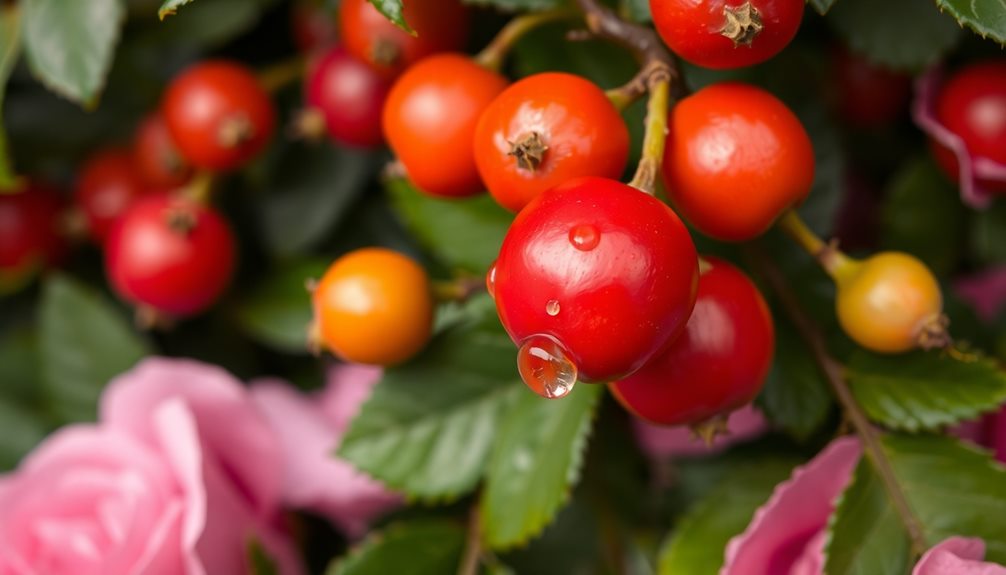
For anyone seeking a gentle yet effective solution for sensitive skin, rosehip oil stands out as an exceptional choice. Packed with essential fatty acids like omega-3 and omega-6, this oil nourishes your skin while bolstering its barrier function.
Its impressive hydration properties help keep your sensitive skin moisturized, preventing dryness and irritation.
But that's not all—rosehip oil is also rich in antioxidants, including vitamin C and retinoic acid. These powerful ingredients promote skin regeneration, reducing the appearance of fine lines and pigmentation.
If you're dealing with aging or dry, sensitive skin, rosehip oil can enhance elasticity and overall hydration.
Thanks to its anti-inflammatory properties, rosehip oil effectively soothes irritated skin and reduces redness, making it a great ally for those with conditions like eczema or rosacea.
Plus, it's non-comedogenic, so you don't have to worry about clogged pores or breakouts.
Incorporating rosehip oil into your skincare routine can be a game-changer, providing the gentle care your sensitive skin craves while delivering multiple benefits.
Give it a try, and watch your skin thrive!
Oatmeal
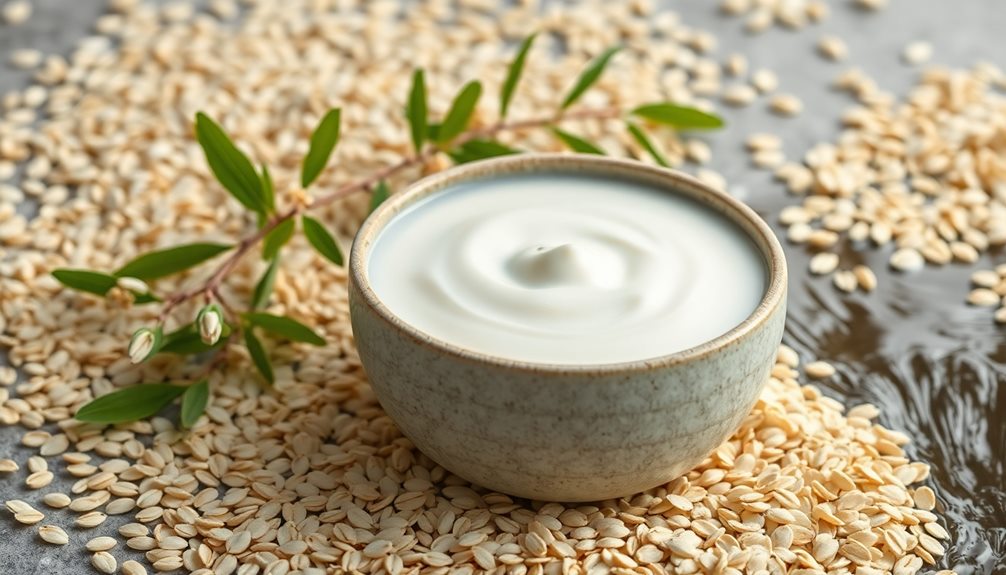
Oatmeal is a powerhouse ingredient for sensitive skin, offering a soothing touch that can make a real difference. This natural remedy is packed with avenanthramides, which provide impressive anti-inflammatory and anti-irritant benefits. When you're dealing with irritation, oatmeal can be a game-changer.
Here are three key benefits of oatmeal for your sensitive skin:
- Hydration: Oatmeal is rich in beta-glucans and starches that help to hydrate and soothe dry, irritated skin. This moisture lock keeps your skin feeling soft and comfortable.
- Barrier Function: Clinical studies show that oatmeal considerably improves skin hydration and strengthens barrier function, acting as a protective layer against environmental irritants. This is essential for maintaining healthy skin.
- Eczema Relief: Colloidal oatmeal, processed specifically for therapeutic use, can effectively relieve symptoms of eczema and rashes, reducing the need for harsh topical steroids.
Incorporating oatmeal into your skincare routine can lead to calmer, healthier skin. Whether in creams or baths, it's a dermatologist-recommended solution for sensitive skin that truly works.
Niacinamide
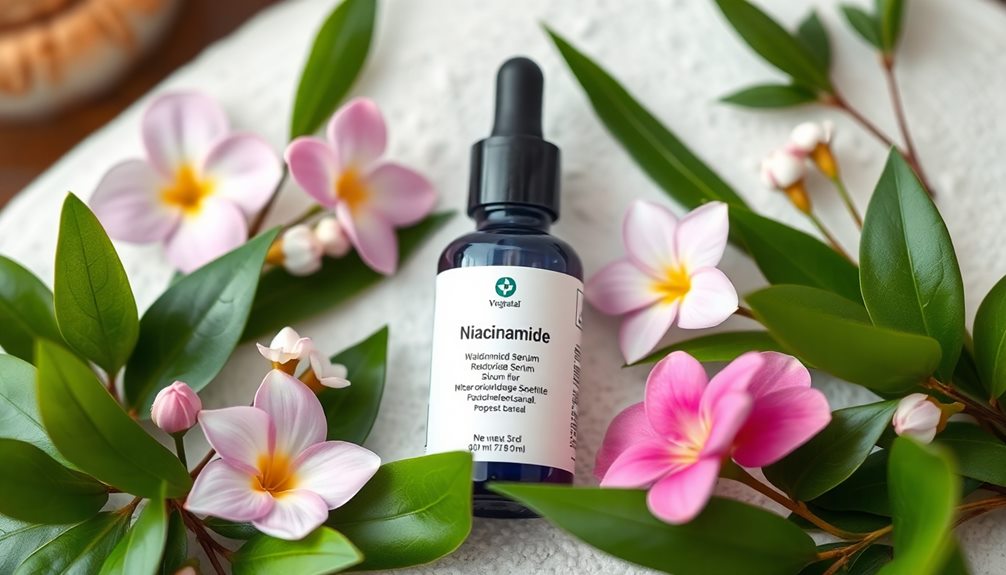
If you're looking for a versatile ingredient to soothe your sensitive skin, niacinamide should be at the top of your list. Also known as vitamin B3, niacinamide excels at enhancing your skin barrier by boosting ceramide production. This means it helps retain moisture and protects your skin against environmental damage.
One of the standout benefits of niacinamide is its ability to notably reduce inflammation, making it a fantastic option for sensitive skin conditions like rosacea and eczema. You'll notice improvements in texture and tone, as niacinamide minimizes the appearance of fine lines and hyperpigmentation, giving you a more even complexion.
Additionally, this ingredient plays an essential role in regulating oil production, which is particularly helpful if your sensitive skin is prone to acne. Unlike many treatments, niacinamide won't irritate your skin; instead, it enhances hydration levels, leading to a plump and youthful appearance.
Incorporating niacinamide into your daily routine can be a game-changer for achieving balanced, healthy skin. So, if you haven't added it yet, now's the perfect time to give your sensitive skin the care it deserves with niacinamide.
Bakuchiol
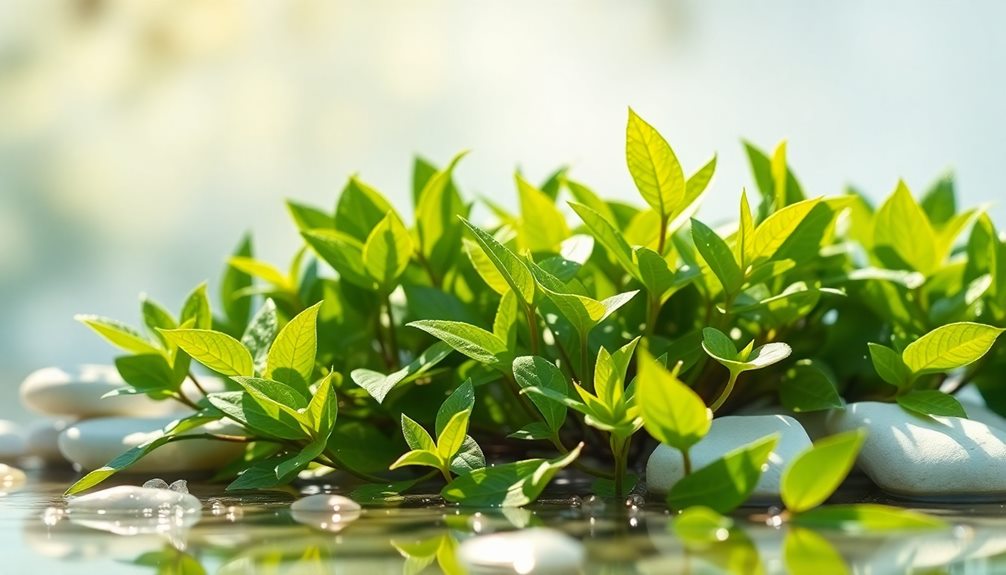
If you're looking for a gentle alternative to retinol, bakuchiol might be just what you need.
This powerful plant-derived ingredient not only helps renew your skin but also soothes inflammation, making it perfect for sensitive skin.
With consistent use, you'll notice improvements in fine lines and overall skin texture without the irritation often associated with traditional retinoids.
Gentle Retinol Alternative
In recent years, bakuchiol has emerged as a gentle, plant-based alternative to retinol, offering similar anti-aging benefits without the irritation that often comes with traditional retinoids.
If you have sensitive skin types, you'll appreciate how this natural ingredient provides results without the common side effects like redness or peeling.
Here are three key benefits of using bakuchiol:
- Anti-Aging Benefits: Research shows that bakuchiol can considerably reduce fine lines and wrinkles, enhancing skin elasticity and improving overall skin texture within just 12 weeks of use.
- Antibacterial Properties: This gentle retinol alternative is also effective for acne-prone skin. Its antibacterial properties help reduce inflammation and prevent breakouts, making it a great choice for those struggling with blemishes.
- Even Skin Tone: Clinical studies indicate that bakuchiol can help address uneven skin tone and hyperpigmentation, leading to a more radiant complexion.
Incorporating bakuchiol into your skincare routine can be a game-changer, allowing you to enjoy the benefits of retinol without the typical drawbacks, ensuring your skin remains healthy and glowing.
Anti-Inflammatory Properties
Bakuchiol's benefits extend beyond its gentle retinol-like effects; it also boasts impressive anti-inflammatory properties. Derived from the babchi herb, bakuchiol is a natural alternative to retinol, making it ideal for sensitive skin types.
Studies show that bakuchiol considerably reduces inflammation, helping to soothe redness and irritation often associated with sensitive skin conditions. Its antioxidant nature plays an essential role in these anti-inflammatory effects, enabling bakuchiol to combat free radicals while promoting overall skin health.
You'll appreciate how this ingredient can enhance collagen production, which supports skin elasticity and fights signs of aging linked to inflammation. Unlike harsher ingredients that might cause irritation, bakuchiol is well-tolerated by most skin types.
This means you can manage inflammatory skin issues effectively without the fear of aggravating your sensitive skin. Incorporating bakuchiol into your routine couldn't only alleviate redness but also contribute to a more youthful, vibrant complexion.
Skin Renewal Benefits
Discovering the skin renewal benefits of bakuchiol can be a game-changer for those with sensitive skin. This powerful, naturally occurring antioxidant derived from the babchi herb offers a gentler alternative to traditional retinoids, delivering impressive results without irritation.
Here are three key skin renewal benefits of bakuchiol:
- Improved Elasticity: Bakuchiol enhances skin elasticity, making it firmer and more resilient over time.
- Reduced Fine Lines: It effectively reduces the appearance of fine lines and wrinkles, helping you achieve a smoother complexion.
- Boosted Collagen Production: This ingredient promotes collagen production and cell turnover, supporting your skin's natural regeneration processes.
Unlike retinol, bakuchiol is well-tolerated by sensitive skin types, allowing you to reap anti-aging benefits without adverse reactions.
Additionally, its antibacterial properties make it beneficial for those with acne-prone skin, as it helps reduce blemishes while promoting a clearer complexion.
Shea Butter
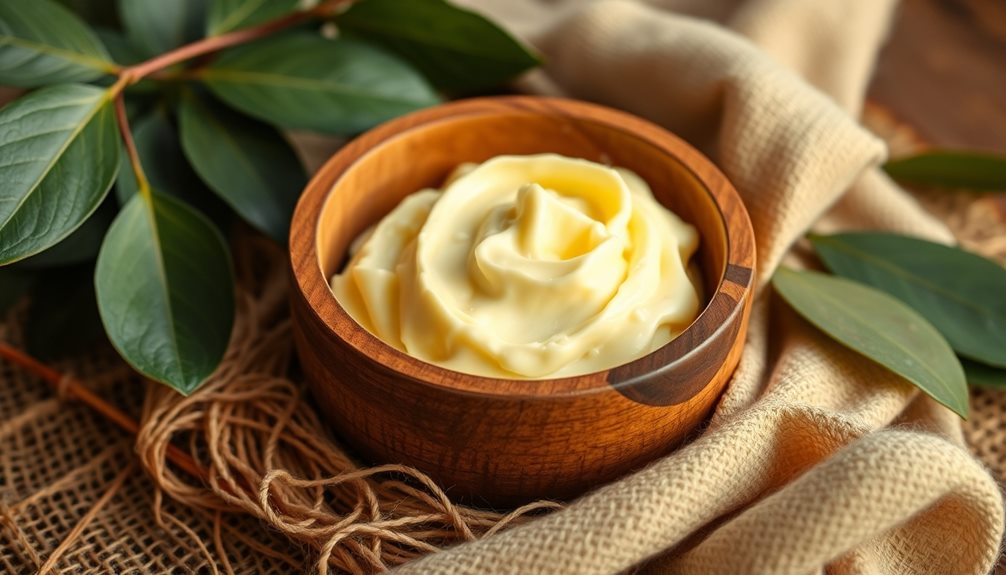
Shea butter, celebrated for its deep moisturizing properties, can be a game-changer for sensitive skin. Derived from the nuts of the shea tree, this natural ingredient is packed with hydration properties that provide your skin with intense moisture.
Rich in fatty acids and vitamins A and E, shea butter not only nourishes but also calms irritated skin, thanks to its anti-inflammatory effects.
Clinical studies have demonstrated that consistent use of shea butter can greatly improve symptoms of eczema within weeks, making it a reliable choice for those dealing with skin sensitivities. The low allergy risk associated with shea butter means it's generally safe for all skin types, including those prone to conditions like psoriasis.
You'll find shea butter in various cosmetic formulations, including body creams and lotions, due to its nourishing and soothing benefits.
Frequently Asked Questions
What Ingredient Is Ideal for Sensitive Skin?
For sensitive skin, try hyaluronic acid. It hydrates effectively without irritation, holding moisture to keep your skin plump and comfortable. Incorporating it into your routine can greatly improve your skin's overall hydration and appearance.
What Is the Best Natural Ingredient for Skin?
You'd think finding the best natural ingredient for skin would involve a treasure map. Surprise! It's aloe vera. It soothes, hydrates, and calms—like a spa day in a bottle. Your skin deserves this treat!
Which Skincare Brand Is Best for Sensitive Skin?
When choosing a skincare brand for sensitive skin, you'll find options like Éminence Organic Skin Care and Dr. Hauschka. They offer gentle, natural products that cater to your skin's unique needs, ensuring comfort and nourishment.
Is Natural Skincare Good for Sensitive Skin?
Natural skincare's great for sensitive skin! You'll find gentle, plant-based ingredients that soothe and hydrate without irritation. Plus, they prioritize transparency, helping you avoid allergens and harmful chemicals that can aggravate your skin.
Conclusion
Incorporating these science-backed natural ingredients into your skincare routine can feel like discovering the fountain of youth for your sensitive skin. Just as ancient remedies have stood the test of time, ingredients like hyaluronic acid and green tea offer proven benefits that nurture and soothe. Embrace the power of nature's best, and you'll find a smoother, healthier complexion waiting for you. Trust in these allies, and watch your skin transform into a radiant masterpiece.
